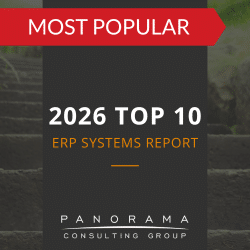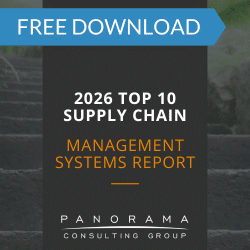Selecting the right ERP software for your company can lead to numerous business benefits. However, achieving these benefits entails an awareness of software selection process best practices.
The secrets to successful selection are spreading like wildfire. If you haven’t heard them, we’ve outlined them for you here.
Contents
1. Don’t Assume You Need a New ERP System
2. Don’t Forget About Your Incumbent ERP Vendor
3. Focus on Business Process Management
4. Consider Multiple Criteria
5. Set Realistic Expectations
6. Don’t Forget About Your Millennial Employees
7. Carefully Manage ERP Vendors
8. Hire an Independent ERP Consultant
1. Don’t Assume You Need A New ERP System
If your business strategies or business processes are flawed, even the most advanced ERP system will be useless.
For example, if you want to improve your customer experience, you don’t necessarily need a new ERP system. In fact, there may be more cost-effective and lower-risk options, such as improving processes, redesigning your organizational structure or consolidating your global supply chain.
When you don’t assume you need new ERP software, you’re more likely to look for specific justifications for ERP since you’re not assuming it’s an obvious choice. Specific justifications are exactly what executives need when deciding to invest in ERP.
So, consider ERP as an option, not a mandate. Then, you will be motivated to outline specific benefits you hope to attain, and you will be well on your way to developing a compelling business case.
A business case should not only outline business benefits but costs, as well. These might include hidden costs, such as internal project resources, data conversion and lost productivity immediately following go-live.
While you may want to contain costs, it’s more important to be realistic as this will ensure an on-time, on-budget project. A business transformation is one of those situations where you get what you pay for, so you should defend what you need to spend and not feel guilty about it.
ERP Selection Guide
This ERP Selection Guide will help you select technology that will support your organization for at least the next ten years.
2. Don’t Forget About Your Incumbent ERP Vendor
We regularly work with clients who want nothing more to do with their current ERP solution. In many cases, end users have an overwhelming impression that the old system doesn’t work.
The reasons for this perception often have little to do with the software itself. More often, discontent is related to the fact that the system was poorly implemented, employees were not adequately trained or the business processes are broken.
Before end users convince you to invest in a new system, you may want to consider some reasons to stick with your incumbent ERP vendor:
Upgrading your ERP software can provide immediate business improvements.
Most ERP vendors make several enhancements throughout any given year, so if you are even just a year behind on upgrades, you may be missing out on key functionality that may address your current pain points.
Several software vendors have acquired other enterprise or point solutions.
ERP vendors have achieved growth through acquisitions over the years, so your current vendor may have products in their portfolio that you are not aware of. In addition to core ERP software offerings, many vendors are acquiring and integrating advanced point solutions that could extend the functionality of your current enterprise system.
An upgrade can yield more cost savings compared to a replacement.
The cost of keeping a customer is lower than losing a customer, so your vendor may be willing to make many concessions on the cost of software licenses, maintenance and upgrades. Another reason upgrades can be less expensive is because your employees are familiar with the current system, so you will likely save on training costs.
Considering your current ERP vendor as a viable option provides more negotiating leverage.
Other vendors competing for your business will know that you don’t have to switch solutions to benefit from a modern ERP system. Therefore, they are more likely to reduce their costs to compete with a viable incumbent. They also understand that the potential cost savings of staying with your current vendor are enticing, so they may offer cost savings, as well.
3. Focus on Business Process Management
Some companies select the vendor with the slickest ERP demo and the coolest features. However, when they begin implementation, they quickly realize that the solution doesn’t meet their business needs.
Then, one of two things usually happens: 1) the company changes the way it does business so their processes work within the ERP system – which often means losing the processes that give them competitive advantage, or 2) the company customizes the software to fit its processes, which is extremely expensive and time-consuming – not to mention these processes may be flawed to begin with.
Preserving competitive advantage and minimizing customization are two reasons many companies begin selection by defining business goals, aligning stakeholders and mapping business processes.
Process mapping also is an opportunity to improve your operations and determine business requirements for a new ERP system.
What is a business requirement? Here are some examples:
- The ability to handle multi-currency
- The ability to track work in progress
- The ability to define discounts based on a contract assigned by a client
Software requirements gathering can be time-consuming, especially if you have multiple business units and multiple global locations. We recommend gathering ERP requirements for each location, while identifying which requirements can be consistent across locations and which should be unique.
This can be especially challenging for public sector organizations pursuing digital government initiatives, as process documentation is often lacking and tribal knowledge is the norm.
Business process management not only entails requirements gathering but also requirements prioritization. It’s important to prioritize requirements because no ERP system can address every business requirement.
When prioritizing requirements, you should involve employees from all departments to determine the most important requirements based on business value:
- Must-have – Provides significant business improvements in terms of revenue, strategy and compliance and maintains basic functions of the business that “keep the lights on.”
- Value-added – Beneficial to improving business processes but not critical.
- Nice-to-have – Makes employees’ jobs easier but won’t necessarily provide significant business process improvement.
4. Consider Multiple Criteria
There are several other criteria besides business requirements, that you should consider in your selection project:
Organizational Alignment
The main reason you should be considering a new ERP system is to help you achieve your business goals. This should be the central focus of your selection process.
Technical Fit
It’s important to understand what servers, databases, PCs, etc. will be required to support any potential ERP solution.
IT Strategy
How does the technology of the potential ERP system align with the technology and infrastructure within your IT department?
Cost
While it’s in vendor sales reps’ best interests to downplay costs, it’s your job to validate their estimate. Does it include annual support fees and implementation costs?
Vendor Viability vs. Level of Service
On one hand, it is good to do business with an established vendor that you know will be around to support you in the future. On the other hand, there is value to doing business with a less established ERP vendor that may provide better service than a larger firm.
References
A vendor’s customers can serve as great references for evaluating the vendor’s products, support and services. Be sure to do your due diligence, read case studies and ask for references from customers with business needs similar to your own.
5. Set Realistic Expectations
Your new ERP system should support your company for up to a decade, so it’s important to mitigate risk by setting realistic expectations.
In terms of timeline, remember that ERP projects rarely take as little time as software sales reps say. To get a more realistic estimate, we recommend developing an ERP project plan that includes activities beyond what vendors typically deliver. These activities might include overlooked items, such as business process design, configuration and customized end user training.
ERP implementation plans should always include training, communication and other organizational aspects critical to a successful project. For example, conducting an organizational readiness assessment prior to ERP selection will help you identify pockets of resistance and determine necessary change management activities.
Another aspect of setting realistic expectations is mitigating risk. We’ve all heard of the technical glitches that shut down shipping at Fortune 500 companies for weeks. This happens all the time at companies of all sizes. In addition, time and cost overruns are a common occurrence, as seen in our 2019 ERP Report.
In light of this grim reality, it’s important to develop a risk management plan that includes contingencies for ERP failure.
Being realistic about vendor sales hype also can help you avoid ERP failure. For example, how many times have you heard one of the following statements when researching ERP solutions?
- “We have the largest market share in your industry, so we are the right fit for you.”
- “Our software is cheaper and easier to implement than other ERP solutions.”
- “The whole industry is moving toward our type of solution, so you should, too.”
While some of these statements may be true in some cases, relying too much on broad generalizations is risky. Your company is too unique for any of these statements to have any bearing on your decision.
Panorama helps clients manage sales hype. We ask clients questions, such as . . .
- How are your business requirements different from those of your peers or competitors?
- How much time and money is it really going to take to fully implement ERP as a business solution, not just a piece of software?
- What are you trying to accomplish with your ERP solution?
These questions help clients delineate between sales hype and reality. This is important because we know how powerful sales hype can be. In fact, gut instinct is a common decision-making mechanism for most humans.
For example, some executives select software based on what competitors have chosen. Other executives have had a previous experience with a particular vendor and are partial toward that vendor.
Separating fact from fiction and business rationale from emotion often requires an independent assessment from a third party, like Panorama.
ERP implementation plans should always include training, communication and other organizational aspects critical to a successful project. For example, conducting an organizational readiness assessment prior to ERP selection will help you identify pockets of resistance and determine necessary change management activities.
Another aspect of setting realistic expectations is mitigating risk. We’ve all heard of the technical glitches that shut down shipping at Fortune 500 companies for weeks. This happens all the time at companies of all sizes. In addition, time and cost overruns are a common occurrence, as seen in our 2019 ERP Report.
In light of this grim reality, it’s important to develop a risk management plan that includes contingencies for ERP failure.
Being realistic about vendor sales hype also can help you avoid ERP failure. For example, how many times have you heard one of the following statements when researching ERP solutions?
- “We have the largest market share in your industry, so we are the right fit for you.”
- “Our software is cheaper and easier to implement than other ERP solutions.”
- “The whole industry is moving toward our type of solution, so you should, too.”
While some of these statements may be true in some cases, relying too much on broad generalizations is risky. Your company is too unique for any of these statements to have any bearing on your decision.
Panorama helps clients manage sales hype. We ask clients questions, such as . . .
- How are your business requirements different from those of your peers or competitors?
- How much time and money is it really going to take to fully implement ERP as a business solution, not just a piece of software?
- What are you trying to accomplish with your ERP solution?
These questions help clients delineate between sales hype and reality. This is important because we know how powerful sales hype can be. In fact, gut instinct is a common decision-making mechanism for most humans.
For example, some executives select software based on what competitors have chosen. Other executives have had a previous experience with a particular vendor and are partial toward that vendor.
Separating fact from fiction and business rationale from emotion often requires an independent assessment from a third party, like Panorama.
6. Don’t Forget About Your Millennial Employees
Have you ever considered which of your employees (non-decision makers) will have the greatest influence your ERP software selection? It may not be who you expect.
The largest generation in the American workforce is the Millennial generation. Depending on your industry, they likely comprise about 35% of your workforce. Naturally, this generation’s preferences and propensities will significantly influence your ERP software selection – if you put any weight on user experience when making IT decisions.
User experience is an important consideration during ERP selection as end-users across departments and across generations will use the new software. You have a lot of people to please.
While people pleasing isn’t generally a fruitful pastime, the rules change when it comes to ERP software. Your evaluation criteria should consider user experience as a factor equally as important as functional requirements and total cost of ownership (TCO). The risks of not considering user experience include low employee morale, low system usage and process inefficiencies.
The influence of the Millennial generation isn’t relegated to its size – its unique characteristics also contribute to its power. Millennials are “digital natives,” meaning they’ve never known life without digital technology. This unique characteristic makes them critical of technology that doesn’t meet their expectations.
For example, Millennials expect software to be intuitive, much like their favorite social media platforms. Their familiarity with social media also primes them to expect software features that promote collaboration.
They also expect accessibility – your ERP software better be mobile-friendly. If it takes more than two clicks to navigate somewhere, they may throw their laptop across the room.
If you want to gauge the more specific needs of your workforce, you can conduct anonymous surveys, encouraging employees to provide honest answers.
Many ERP vendors have accommodated Millennials by building user interfaces that resemble social media platforms, adding social collaboration features, improving their mobile-compatibility and reducing users’ click-fatigue.
Deciding to implement modern ERP software is the first step to meeting the needs of your Millennial employees. However, many companies avoid ERP projects because their legacy applications are “fit-for-purpose,” and seem too expensive to migrate.
Some of these companies resort to time-consuming workarounds to please Millennials. They’ve built new front-end applications to improve the usability of their software, while overlooking inefficiencies throughout the ERP software solution.
Meeting the needs of Millennial employees not only requires careful software selection, but it requires a focus on organizational change management. This should start during the selection process in the form of communication.
Even if you select the best ERP system for Millennials, they will still be resistant to it unless you communicate with them before implementation. This ERP communication should include details about project goals and potential process changes.
7. Carefully Manage ERP Vendors
Don’t let vendors control the selection process. If your vendor is exhibiting any of the following behaviors, consider it a red flag:
- Insists on conducting the demo and evaluation process their way, rather than your company’s preferred way
- Controls the tempo and pace of the evaluation process by requesting that they demo last or at a later date
- Bypasses working with your selection team, and tries to work directly with executives
- Creates doubt by criticizing your project team’s approach
- Cries foul by expressing concern that they don’t have enough time to prep or don’t agree with the selection process
These patterns are generally more common when the ERP vendor feels they are at a competitive disadvantage.
The following methods can be very effective in diffusing vendors’ attempts to control the selection process:
Ensure Vendors Understand Your Business
We recommend sending a request for information (RFI) to all the vendors on your long list. You should also provide vendors with a demo script to ensure they focus their demo on how their solution meets your company’s requirements.
Allow Vendors Access to Your Company’s Key Employees
While many sales reps prefer to build strong relationships with your executive team, they should also interact with your subject matter experts. Without this relationship building, key employees may refuse to participate in the selection process.
Evaluate Vendor Responsiveness
The ERP software you select should come from a vendor that listens and responds to your company’s needs. If a vendor is responsive during the sales process, they are likely to be responsive during implementation, and this is where engagement is especially important.
Remember That You Are the Customer, Not Them
Whatever heartache a sales rep expresses, it is important to remain firm, have confidence in your evaluation process and demand that they earn your business on merit. You are not expecting too much by asking a vendor to demo their ERP system against your business needs rather than simply presenting their canned sales demos.
Coach Executives to Deal With Vendors
It is very likely that at least one vendor will bypass you at some point in the process and go straight to someone higher in the company. Your executive team should be coached on how to handle reps when they call. This might mean redirecting inquires to the ERP project team.
Let a Vendor Walk if Necessary
If a vendor thinks their chances of success are slim, they may walk away from the deal. Your company should allow vendors to self-disqualify. After all, it’s a bad sign if a vendor doesn’t have confidence in their product’s ability to compete.
Negotiate Aggressively
Some vendors will tout their discount rates when first showing you price tags. Don’t be fooled! There are always ways to negotiate even lower license fees and even better maintenance terms. Focus your ERP negotiations not just on short-term costs, but also on longer-term costs, such as future licenses, additional modules and long-term maintenance.
Clearly Define Scope
Make sure you understand what the vendor is and is not responsible for during implementation. For example, who is responsible for ERP data migration and end user training?
Find the Best Implementer
As strange as it sounds, software companies aren’t always the best implementers of their own software. In fact, you can often find better implementers at a lower cost by hiring a value-added reseller (VAR).
8. Hire an Independent ERP Consultant
Unfortunately, many ERP consultants are too quick to make recommendations based on biases, kickbacks from ERP vendors and lack of knowledge of various software solutions.
Independent ERP consultants, on the other hand, bring a neutral point-of-view to the selection process.
In addition to being independent, consultants should have experience in your industry. Industry-specific experience has many benefits for your company. For example, it enables consultants to determine which of your processes should be standardized and which should be differentiated.
An independent ERP consultant, like Panorama, will help you follow all the best practices outlined in this post. We’ll help you find an ERP system that aligns with your business goals.














